Principles of Management Assignment: Global Strategy and Communication
VerifiedAdded on 2020/05/04
|8
|2014
|192
Homework Assignment
AI Summary
This assignment delves into the core principles of management, exploring how organizations can expand internationally, and the impact of global environments on managers. It examines the different ways businesses can go global, including joint ventures and identifying local leaders. The assignment also analyzes how political, legal, and economic factors influence managerial decisions in a global context. Furthermore, it differentiates between social obligation, social responsiveness, and social responsibility, and discusses the importance of corporate social responsibility. The document also defines communication, interpersonal communication, and organizational communication, highlighting the components of the communication process and various methods managers can utilize, alongside evaluation criteria for these methods. The student's assignment provides a comprehensive overview of key management concepts and challenges in a globalized world.
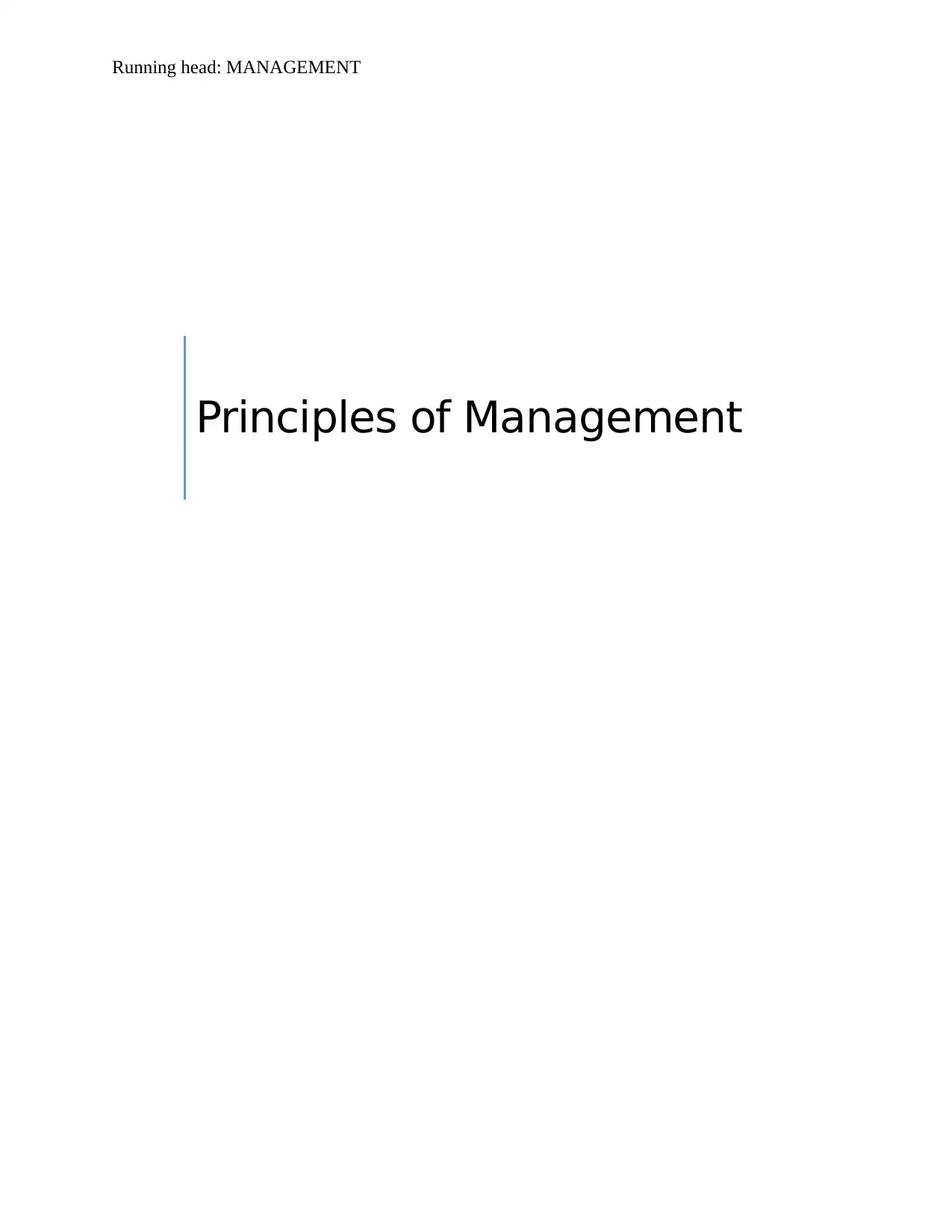
Running head: MANAGEMENT
Principles of Management
Principles of Management
Paraphrase This Document
Need a fresh take? Get an instant paraphrase of this document with our AI Paraphraser
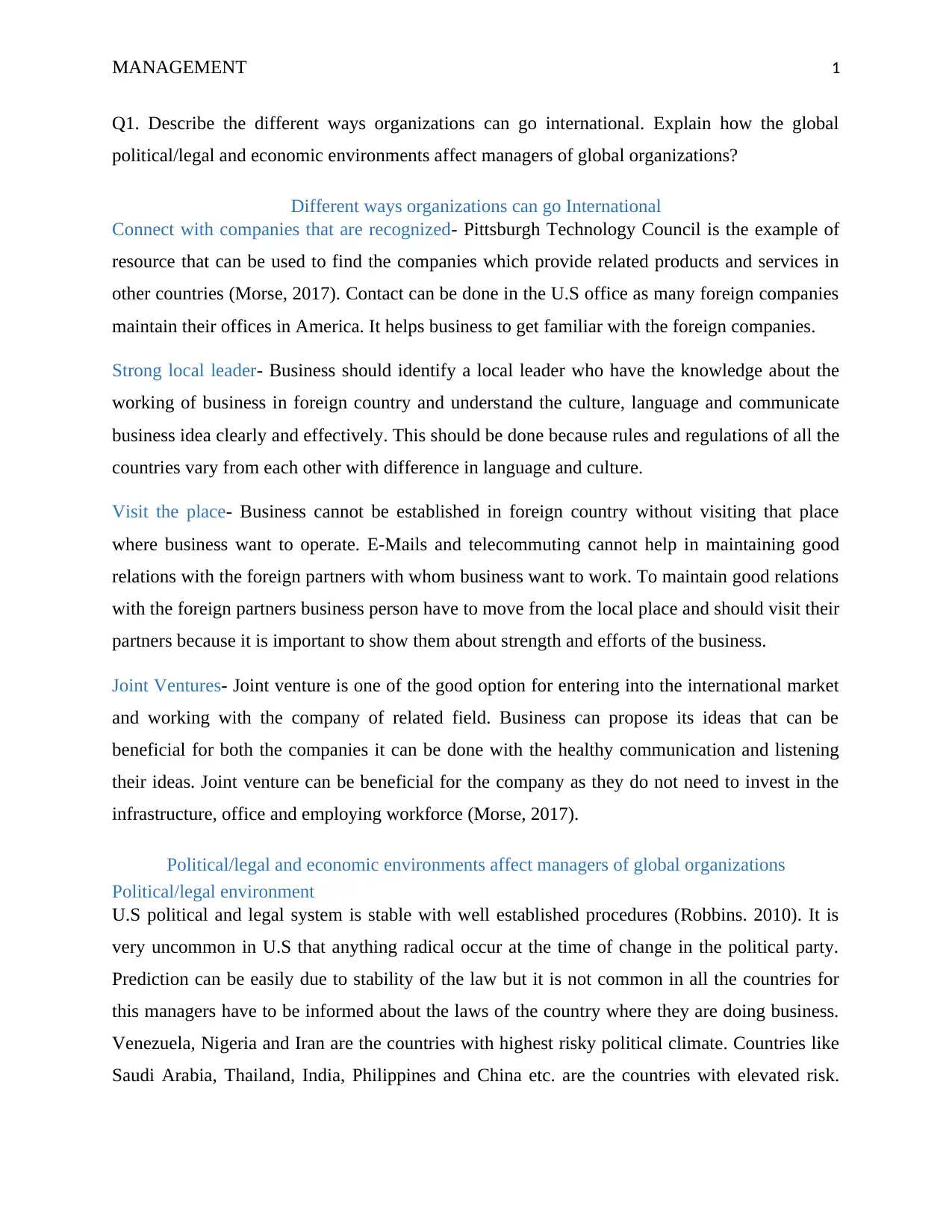
MANAGEMENT 1
Q1. Describe the different ways organizations can go international. Explain how the global
political/legal and economic environments affect managers of global organizations?
Different ways organizations can go International
Connect with companies that are recognized- Pittsburgh Technology Council is the example of
resource that can be used to find the companies which provide related products and services in
other countries (Morse, 2017). Contact can be done in the U.S office as many foreign companies
maintain their offices in America. It helps business to get familiar with the foreign companies.
Strong local leader- Business should identify a local leader who have the knowledge about the
working of business in foreign country and understand the culture, language and communicate
business idea clearly and effectively. This should be done because rules and regulations of all the
countries vary from each other with difference in language and culture.
Visit the place- Business cannot be established in foreign country without visiting that place
where business want to operate. E-Mails and telecommuting cannot help in maintaining good
relations with the foreign partners with whom business want to work. To maintain good relations
with the foreign partners business person have to move from the local place and should visit their
partners because it is important to show them about strength and efforts of the business.
Joint Ventures- Joint venture is one of the good option for entering into the international market
and working with the company of related field. Business can propose its ideas that can be
beneficial for both the companies it can be done with the healthy communication and listening
their ideas. Joint venture can be beneficial for the company as they do not need to invest in the
infrastructure, office and employing workforce (Morse, 2017).
Political/legal and economic environments affect managers of global organizations
Political/legal environment
U.S political and legal system is stable with well established procedures (Robbins. 2010). It is
very uncommon in U.S that anything radical occur at the time of change in the political party.
Prediction can be easily due to stability of the law but it is not common in all the countries for
this managers have to be informed about the laws of the country where they are doing business.
Venezuela, Nigeria and Iran are the countries with highest risky political climate. Countries like
Saudi Arabia, Thailand, India, Philippines and China etc. are the countries with elevated risk.
Q1. Describe the different ways organizations can go international. Explain how the global
political/legal and economic environments affect managers of global organizations?
Different ways organizations can go International
Connect with companies that are recognized- Pittsburgh Technology Council is the example of
resource that can be used to find the companies which provide related products and services in
other countries (Morse, 2017). Contact can be done in the U.S office as many foreign companies
maintain their offices in America. It helps business to get familiar with the foreign companies.
Strong local leader- Business should identify a local leader who have the knowledge about the
working of business in foreign country and understand the culture, language and communicate
business idea clearly and effectively. This should be done because rules and regulations of all the
countries vary from each other with difference in language and culture.
Visit the place- Business cannot be established in foreign country without visiting that place
where business want to operate. E-Mails and telecommuting cannot help in maintaining good
relations with the foreign partners with whom business want to work. To maintain good relations
with the foreign partners business person have to move from the local place and should visit their
partners because it is important to show them about strength and efforts of the business.
Joint Ventures- Joint venture is one of the good option for entering into the international market
and working with the company of related field. Business can propose its ideas that can be
beneficial for both the companies it can be done with the healthy communication and listening
their ideas. Joint venture can be beneficial for the company as they do not need to invest in the
infrastructure, office and employing workforce (Morse, 2017).
Political/legal and economic environments affect managers of global organizations
Political/legal environment
U.S political and legal system is stable with well established procedures (Robbins. 2010). It is
very uncommon in U.S that anything radical occur at the time of change in the political party.
Prediction can be easily due to stability of the law but it is not common in all the countries for
this managers have to be informed about the laws of the country where they are doing business.
Venezuela, Nigeria and Iran are the countries with highest risky political climate. Countries like
Saudi Arabia, Thailand, India, Philippines and China etc. are the countries with elevated risk.
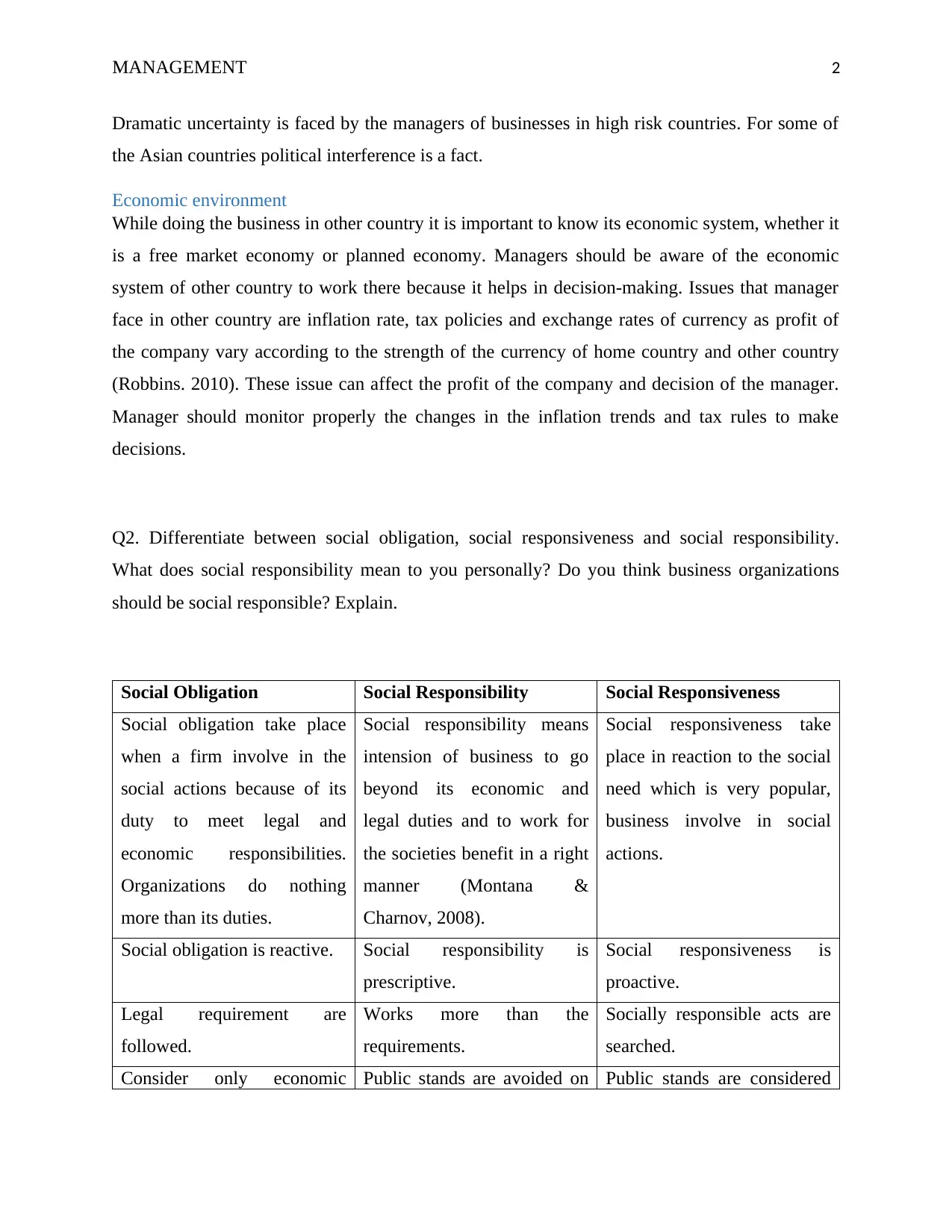
MANAGEMENT 2
Dramatic uncertainty is faced by the managers of businesses in high risk countries. For some of
the Asian countries political interference is a fact.
Economic environment
While doing the business in other country it is important to know its economic system, whether it
is a free market economy or planned economy. Managers should be aware of the economic
system of other country to work there because it helps in decision-making. Issues that manager
face in other country are inflation rate, tax policies and exchange rates of currency as profit of
the company vary according to the strength of the currency of home country and other country
(Robbins. 2010). These issue can affect the profit of the company and decision of the manager.
Manager should monitor properly the changes in the inflation trends and tax rules to make
decisions.
Q2. Differentiate between social obligation, social responsiveness and social responsibility.
What does social responsibility mean to you personally? Do you think business organizations
should be social responsible? Explain.
Social Obligation Social Responsibility Social Responsiveness
Social obligation take place
when a firm involve in the
social actions because of its
duty to meet legal and
economic responsibilities.
Organizations do nothing
more than its duties.
Social responsibility means
intension of business to go
beyond its economic and
legal duties and to work for
the societies benefit in a right
manner (Montana &
Charnov, 2008).
Social responsiveness take
place in reaction to the social
need which is very popular,
business involve in social
actions.
Social obligation is reactive. Social responsibility is
prescriptive.
Social responsiveness is
proactive.
Legal requirement are
followed.
Works more than the
requirements.
Socially responsible acts are
searched.
Consider only economic Public stands are avoided on Public stands are considered
Dramatic uncertainty is faced by the managers of businesses in high risk countries. For some of
the Asian countries political interference is a fact.
Economic environment
While doing the business in other country it is important to know its economic system, whether it
is a free market economy or planned economy. Managers should be aware of the economic
system of other country to work there because it helps in decision-making. Issues that manager
face in other country are inflation rate, tax policies and exchange rates of currency as profit of
the company vary according to the strength of the currency of home country and other country
(Robbins. 2010). These issue can affect the profit of the company and decision of the manager.
Manager should monitor properly the changes in the inflation trends and tax rules to make
decisions.
Q2. Differentiate between social obligation, social responsiveness and social responsibility.
What does social responsibility mean to you personally? Do you think business organizations
should be social responsible? Explain.
Social Obligation Social Responsibility Social Responsiveness
Social obligation take place
when a firm involve in the
social actions because of its
duty to meet legal and
economic responsibilities.
Organizations do nothing
more than its duties.
Social responsibility means
intension of business to go
beyond its economic and
legal duties and to work for
the societies benefit in a right
manner (Montana &
Charnov, 2008).
Social responsiveness take
place in reaction to the social
need which is very popular,
business involve in social
actions.
Social obligation is reactive. Social responsibility is
prescriptive.
Social responsiveness is
proactive.
Legal requirement are
followed.
Works more than the
requirements.
Socially responsible acts are
searched.
Consider only economic Public stands are avoided on Public stands are considered
⊘ This is a preview!⊘
Do you want full access?
Subscribe today to unlock all pages.

Trusted by 1+ million students worldwide
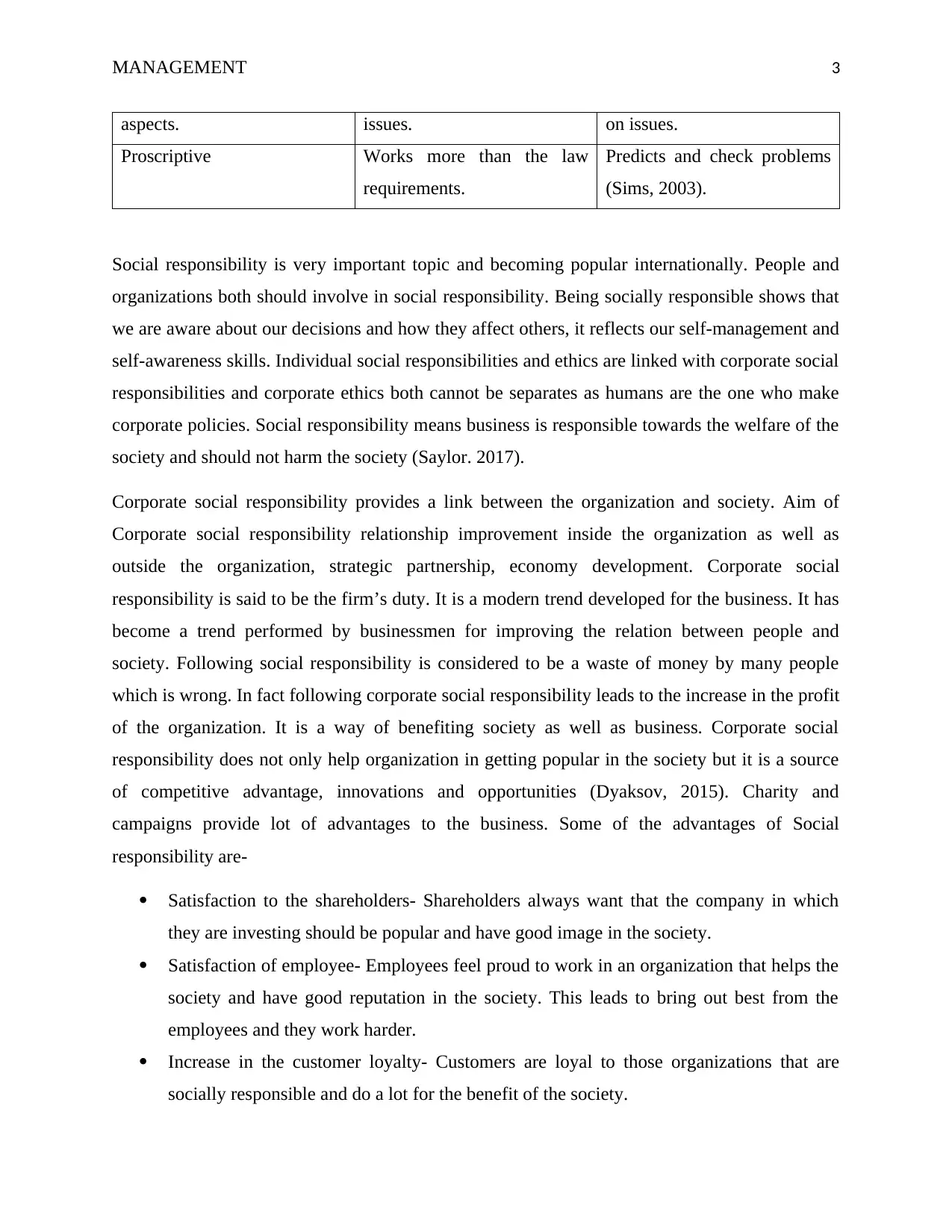
MANAGEMENT 3
aspects. issues. on issues.
Proscriptive Works more than the law
requirements.
Predicts and check problems
(Sims, 2003).
Social responsibility is very important topic and becoming popular internationally. People and
organizations both should involve in social responsibility. Being socially responsible shows that
we are aware about our decisions and how they affect others, it reflects our self-management and
self-awareness skills. Individual social responsibilities and ethics are linked with corporate social
responsibilities and corporate ethics both cannot be separates as humans are the one who make
corporate policies. Social responsibility means business is responsible towards the welfare of the
society and should not harm the society (Saylor. 2017).
Corporate social responsibility provides a link between the organization and society. Aim of
Corporate social responsibility relationship improvement inside the organization as well as
outside the organization, strategic partnership, economy development. Corporate social
responsibility is said to be the firm’s duty. It is a modern trend developed for the business. It has
become a trend performed by businessmen for improving the relation between people and
society. Following social responsibility is considered to be a waste of money by many people
which is wrong. In fact following corporate social responsibility leads to the increase in the profit
of the organization. It is a way of benefiting society as well as business. Corporate social
responsibility does not only help organization in getting popular in the society but it is a source
of competitive advantage, innovations and opportunities (Dyaksov, 2015). Charity and
campaigns provide lot of advantages to the business. Some of the advantages of Social
responsibility are-
Satisfaction to the shareholders- Shareholders always want that the company in which
they are investing should be popular and have good image in the society.
Satisfaction of employee- Employees feel proud to work in an organization that helps the
society and have good reputation in the society. This leads to bring out best from the
employees and they work harder.
Increase in the customer loyalty- Customers are loyal to those organizations that are
socially responsible and do a lot for the benefit of the society.
aspects. issues. on issues.
Proscriptive Works more than the law
requirements.
Predicts and check problems
(Sims, 2003).
Social responsibility is very important topic and becoming popular internationally. People and
organizations both should involve in social responsibility. Being socially responsible shows that
we are aware about our decisions and how they affect others, it reflects our self-management and
self-awareness skills. Individual social responsibilities and ethics are linked with corporate social
responsibilities and corporate ethics both cannot be separates as humans are the one who make
corporate policies. Social responsibility means business is responsible towards the welfare of the
society and should not harm the society (Saylor. 2017).
Corporate social responsibility provides a link between the organization and society. Aim of
Corporate social responsibility relationship improvement inside the organization as well as
outside the organization, strategic partnership, economy development. Corporate social
responsibility is said to be the firm’s duty. It is a modern trend developed for the business. It has
become a trend performed by businessmen for improving the relation between people and
society. Following social responsibility is considered to be a waste of money by many people
which is wrong. In fact following corporate social responsibility leads to the increase in the profit
of the organization. It is a way of benefiting society as well as business. Corporate social
responsibility does not only help organization in getting popular in the society but it is a source
of competitive advantage, innovations and opportunities (Dyaksov, 2015). Charity and
campaigns provide lot of advantages to the business. Some of the advantages of Social
responsibility are-
Satisfaction to the shareholders- Shareholders always want that the company in which
they are investing should be popular and have good image in the society.
Satisfaction of employee- Employees feel proud to work in an organization that helps the
society and have good reputation in the society. This leads to bring out best from the
employees and they work harder.
Increase in the customer loyalty- Customers are loyal to those organizations that are
socially responsible and do a lot for the benefit of the society.
Paraphrase This Document
Need a fresh take? Get an instant paraphrase of this document with our AI Paraphraser
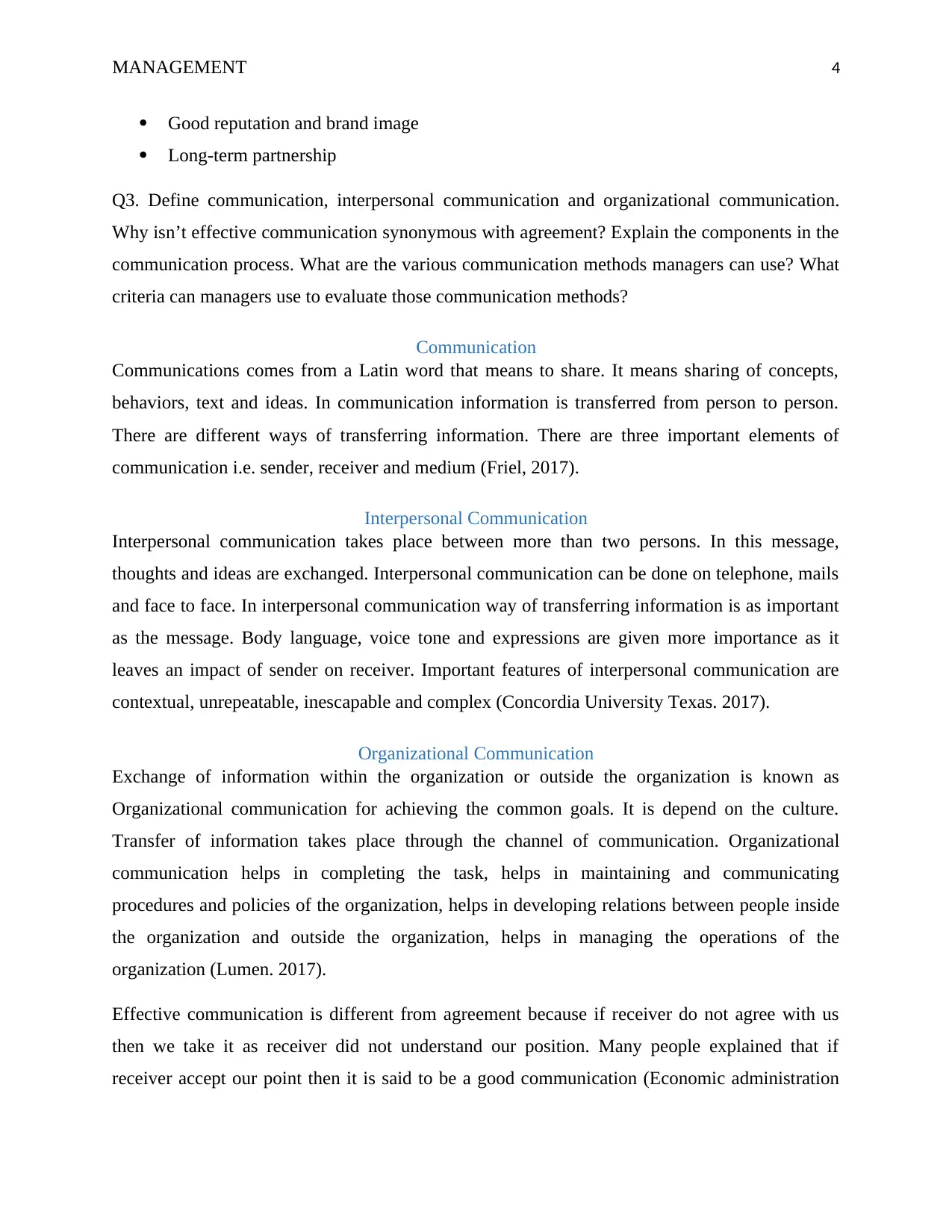
MANAGEMENT 4
Good reputation and brand image
Long-term partnership
Q3. Define communication, interpersonal communication and organizational communication.
Why isn’t effective communication synonymous with agreement? Explain the components in the
communication process. What are the various communication methods managers can use? What
criteria can managers use to evaluate those communication methods?
Communication
Communications comes from a Latin word that means to share. It means sharing of concepts,
behaviors, text and ideas. In communication information is transferred from person to person.
There are different ways of transferring information. There are three important elements of
communication i.e. sender, receiver and medium (Friel, 2017).
Interpersonal Communication
Interpersonal communication takes place between more than two persons. In this message,
thoughts and ideas are exchanged. Interpersonal communication can be done on telephone, mails
and face to face. In interpersonal communication way of transferring information is as important
as the message. Body language, voice tone and expressions are given more importance as it
leaves an impact of sender on receiver. Important features of interpersonal communication are
contextual, unrepeatable, inescapable and complex (Concordia University Texas. 2017).
Organizational Communication
Exchange of information within the organization or outside the organization is known as
Organizational communication for achieving the common goals. It is depend on the culture.
Transfer of information takes place through the channel of communication. Organizational
communication helps in completing the task, helps in maintaining and communicating
procedures and policies of the organization, helps in developing relations between people inside
the organization and outside the organization, helps in managing the operations of the
organization (Lumen. 2017).
Effective communication is different from agreement because if receiver do not agree with us
then we take it as receiver did not understand our position. Many people explained that if
receiver accept our point then it is said to be a good communication (Economic administration
Good reputation and brand image
Long-term partnership
Q3. Define communication, interpersonal communication and organizational communication.
Why isn’t effective communication synonymous with agreement? Explain the components in the
communication process. What are the various communication methods managers can use? What
criteria can managers use to evaluate those communication methods?
Communication
Communications comes from a Latin word that means to share. It means sharing of concepts,
behaviors, text and ideas. In communication information is transferred from person to person.
There are different ways of transferring information. There are three important elements of
communication i.e. sender, receiver and medium (Friel, 2017).
Interpersonal Communication
Interpersonal communication takes place between more than two persons. In this message,
thoughts and ideas are exchanged. Interpersonal communication can be done on telephone, mails
and face to face. In interpersonal communication way of transferring information is as important
as the message. Body language, voice tone and expressions are given more importance as it
leaves an impact of sender on receiver. Important features of interpersonal communication are
contextual, unrepeatable, inescapable and complex (Concordia University Texas. 2017).
Organizational Communication
Exchange of information within the organization or outside the organization is known as
Organizational communication for achieving the common goals. It is depend on the culture.
Transfer of information takes place through the channel of communication. Organizational
communication helps in completing the task, helps in maintaining and communicating
procedures and policies of the organization, helps in developing relations between people inside
the organization and outside the organization, helps in managing the operations of the
organization (Lumen. 2017).
Effective communication is different from agreement because if receiver do not agree with us
then we take it as receiver did not understand our position. Many people explained that if
receiver accept our point then it is said to be a good communication (Economic administration
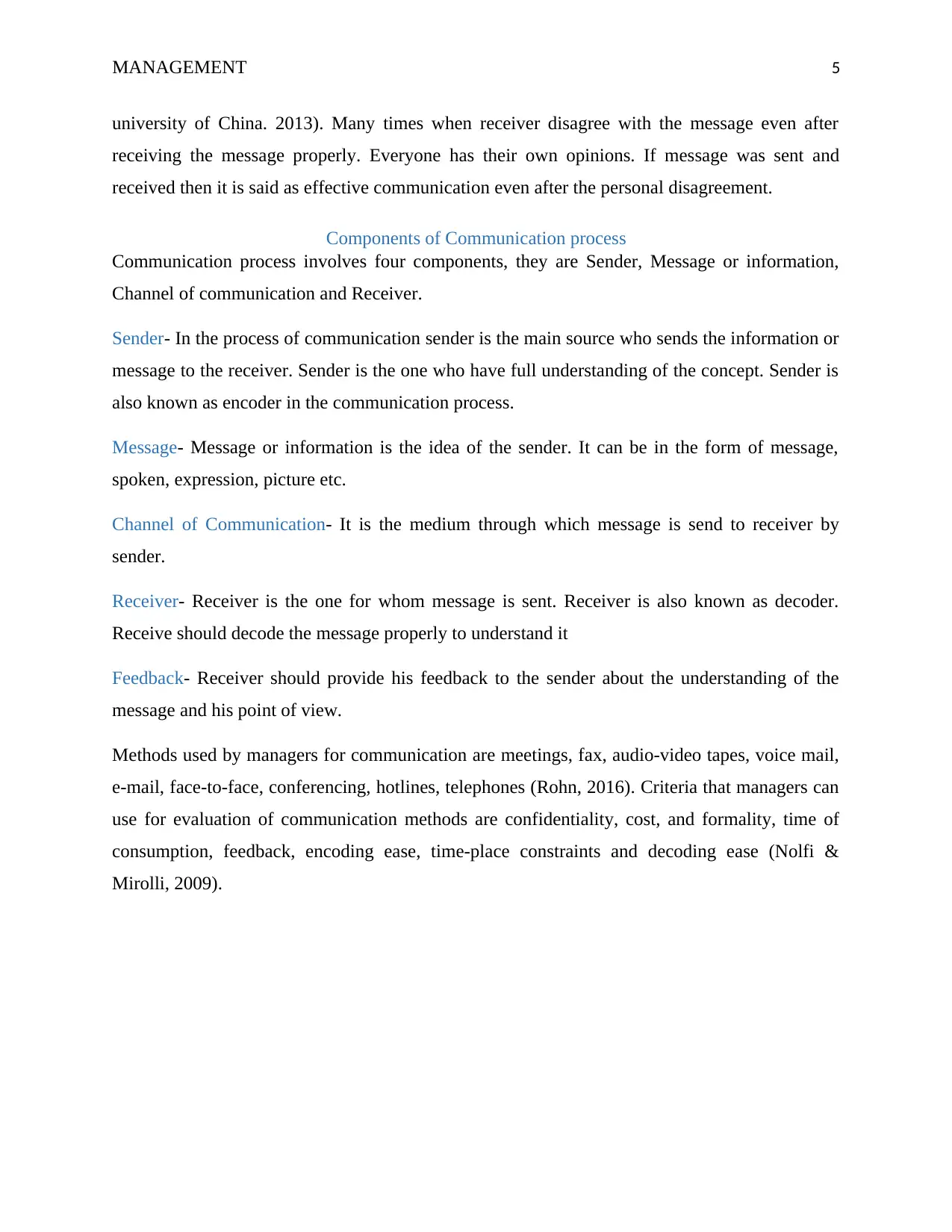
MANAGEMENT 5
university of China. 2013). Many times when receiver disagree with the message even after
receiving the message properly. Everyone has their own opinions. If message was sent and
received then it is said as effective communication even after the personal disagreement.
Components of Communication process
Communication process involves four components, they are Sender, Message or information,
Channel of communication and Receiver.
Sender- In the process of communication sender is the main source who sends the information or
message to the receiver. Sender is the one who have full understanding of the concept. Sender is
also known as encoder in the communication process.
Message- Message or information is the idea of the sender. It can be in the form of message,
spoken, expression, picture etc.
Channel of Communication- It is the medium through which message is send to receiver by
sender.
Receiver- Receiver is the one for whom message is sent. Receiver is also known as decoder.
Receive should decode the message properly to understand it
Feedback- Receiver should provide his feedback to the sender about the understanding of the
message and his point of view.
Methods used by managers for communication are meetings, fax, audio-video tapes, voice mail,
e-mail, face-to-face, conferencing, hotlines, telephones (Rohn, 2016). Criteria that managers can
use for evaluation of communication methods are confidentiality, cost, and formality, time of
consumption, feedback, encoding ease, time-place constraints and decoding ease (Nolfi &
Mirolli, 2009).
university of China. 2013). Many times when receiver disagree with the message even after
receiving the message properly. Everyone has their own opinions. If message was sent and
received then it is said as effective communication even after the personal disagreement.
Components of Communication process
Communication process involves four components, they are Sender, Message or information,
Channel of communication and Receiver.
Sender- In the process of communication sender is the main source who sends the information or
message to the receiver. Sender is the one who have full understanding of the concept. Sender is
also known as encoder in the communication process.
Message- Message or information is the idea of the sender. It can be in the form of message,
spoken, expression, picture etc.
Channel of Communication- It is the medium through which message is send to receiver by
sender.
Receiver- Receiver is the one for whom message is sent. Receiver is also known as decoder.
Receive should decode the message properly to understand it
Feedback- Receiver should provide his feedback to the sender about the understanding of the
message and his point of view.
Methods used by managers for communication are meetings, fax, audio-video tapes, voice mail,
e-mail, face-to-face, conferencing, hotlines, telephones (Rohn, 2016). Criteria that managers can
use for evaluation of communication methods are confidentiality, cost, and formality, time of
consumption, feedback, encoding ease, time-place constraints and decoding ease (Nolfi &
Mirolli, 2009).
⊘ This is a preview!⊘
Do you want full access?
Subscribe today to unlock all pages.

Trusted by 1+ million students worldwide
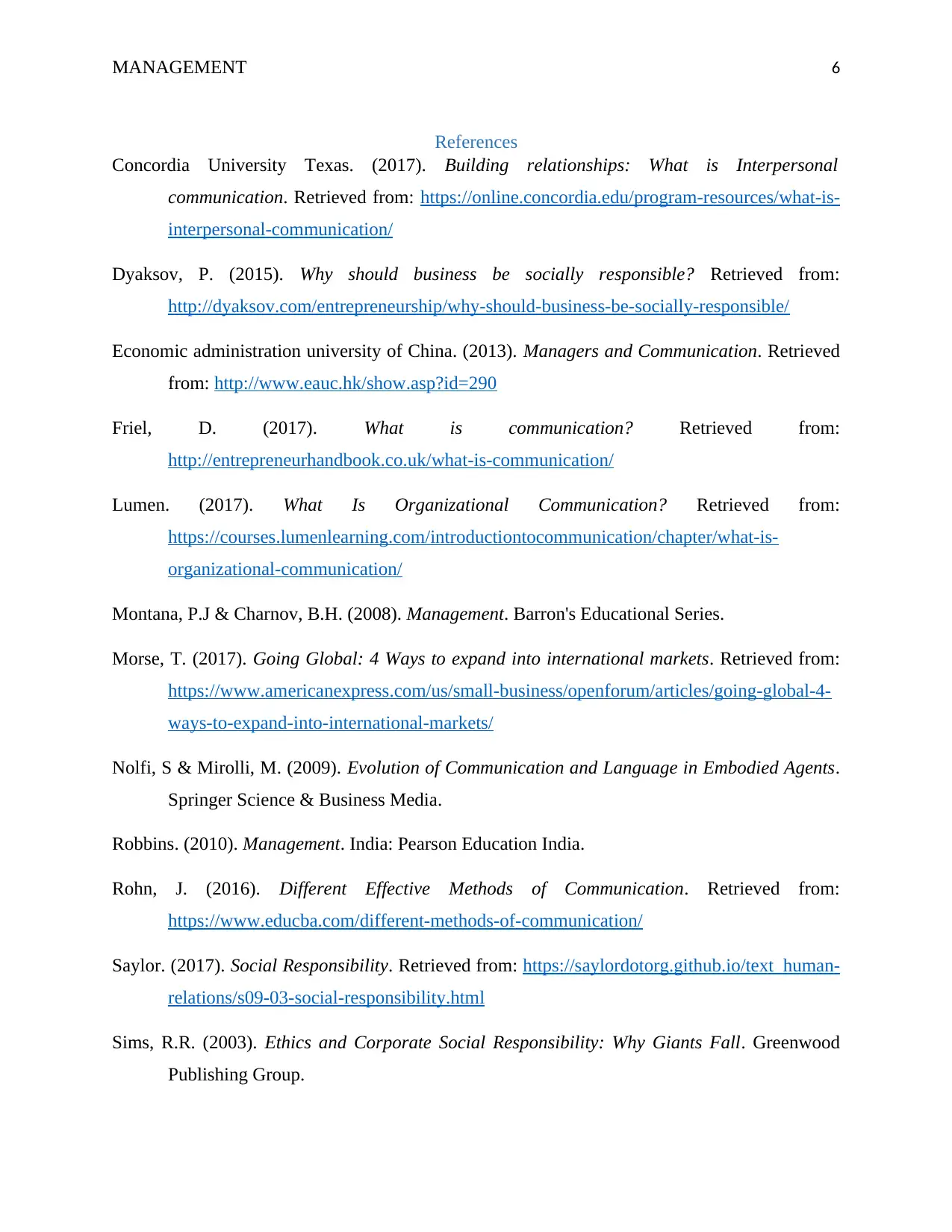
MANAGEMENT 6
References
Concordia University Texas. (2017). Building relationships: What is Interpersonal
communication. Retrieved from: https://online.concordia.edu/program-resources/what-is-
interpersonal-communication/
Dyaksov, P. (2015). Why should business be socially responsible? Retrieved from:
http://dyaksov.com/entrepreneurship/why-should-business-be-socially-responsible/
Economic administration university of China. (2013). Managers and Communication. Retrieved
from: http://www.eauc.hk/show.asp?id=290
Friel, D. (2017). What is communication? Retrieved from:
http://entrepreneurhandbook.co.uk/what-is-communication/
Lumen. (2017). What Is Organizational Communication? Retrieved from:
https://courses.lumenlearning.com/introductiontocommunication/chapter/what-is-
organizational-communication/
Montana, P.J & Charnov, B.H. (2008). Management. Barron's Educational Series.
Morse, T. (2017). Going Global: 4 Ways to expand into international markets. Retrieved from:
https://www.americanexpress.com/us/small-business/openforum/articles/going-global-4-
ways-to-expand-into-international-markets/
Nolfi, S & Mirolli, M. (2009). Evolution of Communication and Language in Embodied Agents.
Springer Science & Business Media.
Robbins. (2010). Management. India: Pearson Education India.
Rohn, J. (2016). Different Effective Methods of Communication. Retrieved from:
https://www.educba.com/different-methods-of-communication/
Saylor. (2017). Social Responsibility. Retrieved from: https://saylordotorg.github.io/text_human-
relations/s09-03-social-responsibility.html
Sims, R.R. (2003). Ethics and Corporate Social Responsibility: Why Giants Fall. Greenwood
Publishing Group.
References
Concordia University Texas. (2017). Building relationships: What is Interpersonal
communication. Retrieved from: https://online.concordia.edu/program-resources/what-is-
interpersonal-communication/
Dyaksov, P. (2015). Why should business be socially responsible? Retrieved from:
http://dyaksov.com/entrepreneurship/why-should-business-be-socially-responsible/
Economic administration university of China. (2013). Managers and Communication. Retrieved
from: http://www.eauc.hk/show.asp?id=290
Friel, D. (2017). What is communication? Retrieved from:
http://entrepreneurhandbook.co.uk/what-is-communication/
Lumen. (2017). What Is Organizational Communication? Retrieved from:
https://courses.lumenlearning.com/introductiontocommunication/chapter/what-is-
organizational-communication/
Montana, P.J & Charnov, B.H. (2008). Management. Barron's Educational Series.
Morse, T. (2017). Going Global: 4 Ways to expand into international markets. Retrieved from:
https://www.americanexpress.com/us/small-business/openforum/articles/going-global-4-
ways-to-expand-into-international-markets/
Nolfi, S & Mirolli, M. (2009). Evolution of Communication and Language in Embodied Agents.
Springer Science & Business Media.
Robbins. (2010). Management. India: Pearson Education India.
Rohn, J. (2016). Different Effective Methods of Communication. Retrieved from:
https://www.educba.com/different-methods-of-communication/
Saylor. (2017). Social Responsibility. Retrieved from: https://saylordotorg.github.io/text_human-
relations/s09-03-social-responsibility.html
Sims, R.R. (2003). Ethics and Corporate Social Responsibility: Why Giants Fall. Greenwood
Publishing Group.
Paraphrase This Document
Need a fresh take? Get an instant paraphrase of this document with our AI Paraphraser

MANAGEMENT 7
1 out of 8
Related Documents
Your All-in-One AI-Powered Toolkit for Academic Success.
+13062052269
info@desklib.com
Available 24*7 on WhatsApp / Email
![[object Object]](/_next/static/media/star-bottom.7253800d.svg)
Unlock your academic potential
Copyright © 2020–2025 A2Z Services. All Rights Reserved. Developed and managed by ZUCOL.





